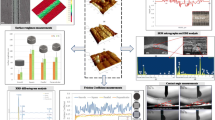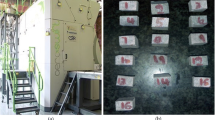Abstract
This paper deals with an experimental investigation of roughness influence on contact angle measurements and proposes a genetic algorithm to identify an empirical regression model to combine roughness and contact angles. A ns-pulsed laser was adopted to ablate different patterns on the surfaces of AISI 304 samples. During the tests, number of repetitions, hatch distance, laser scan speed and laser scanning strategy were changed. To assess the effect of these parameters on the wettability, a multilevel factorial design was developed and tested. The analysis of variance was adopted to determine which and how the laser parameters influence the roughness and the contact angle. A significant change in the wettability is due to the produced textures on the sample surfaces, with contact angles in the range 30–110°. The optimal regression model based on genetic algorithms was able to relate inputs and outputs with a mean error lower than 5%.



















Similar content being viewed by others
Data availability
The raw/processed data required to reproduce these findings cannot be shared at this time as the data also forms part of an ongoing study.
Abbreviations
- Adj MS:
-
Adjusted mean sum of squares
- Adj SS:
-
Adjusted sum of squares
- CB :
-
Cassie-Baxter state
- C k :
-
Set of the chromosome
- DF:
-
Total degrees of freedom
- E max :
-
Pulse energy (mJ)
- f :
-
Fraction of the wet solid surface
- F :
-
Pulse frequency (kHz)
- f f :
-
Fitness function
- GA:
-
Genetic algorithm
- H :
-
Height of the droplet (mm)
- Hd :
-
Hatch distance (μm)
- h(R, Ss, Hd):
-
Response variable
- k j :
-
Coefficients of the GA regression model
- l i :
-
Coefficients of the linear regression model
- Lin:
-
Linear model
- N :
-
Number of chromosomes
- N C :
-
Number of combinations
- N T :
-
Number of terms of the regression model
- pHd, pR, pSs :
-
Powers of the input parameters
- P N :
-
Nominal average power (W)
- P P :
-
Peak power (kW)
- r :
-
Radius of the droplet projected on the base (mm)
- R :
-
Number of repetitions
- Ra:
-
Average roughness (μm)
- r f :
-
Roughness factor
- rms:
-
Root mean square operation
- RMS:
-
Root mean square error
- S :
-
Scanning strategy
- Ss :
-
Laser scanning speed (mm/s)
- Sdr:
-
Developed surface area ratio
- Std:
-
Standard deviation
- t D :
-
Pulse duration [ns]
- W :
-
Wenzel state
- wt%:
-
Weight percentage
- y(R, Ss, Hd):
-
Measured value
- θ CB :
-
Cassie-Baxter’s contact angle (°)
- θ W :
-
Wenzel’s contact angle (°)
- θ Y :
-
Young’s contact angle (°)
- ϑ :
-
Contact angle (°)
- λ :
-
Laser wavelength (nm)
- Π:
-
Contribution percentage
References
Etsion I (2005) State of the art in laser surface texturing. J Tribol 127:248–253. https://doi.org/10.1115/1.1828070
Bruzzone AAG, Costa HL, Lonardo PM, Lucca DA (2008) Advances in engineered surfaces for functional performance. CIRP Ann 57:750–769. https://doi.org/10.1016/j.cirp.2008.09.003
Gachot C, Rosenkranz A, Hsu SM, Costa HL (2017) A critical assessment of surface texturing for friction and wear improvement. Wear 372–373:21–41. https://doi.org/10.1016/j.wear.2016.11.020
Costa H, Hutchings I (2015) Some innovative surface texturing techniques for tribological purposes. Proc Inst Mech Eng Part J J Eng Tribol 229:429–448. https://doi.org/10.1177/1350650114539936
Wos S, Koszela W, Pawlus P, Drabik J, Rogos E (2018) Effects of surface texturing and kind of lubricant on the coefficient of friction at ambient and elevated temperatures. Tribol Int 117:174–179. https://doi.org/10.1016/j.triboint.2017.09.003
Minami T, Miyata T, Uozaki R, Sai H, Koida T (2016) Textured surface structures formed using new techniques on transparent conducting Al-doped zinc oxide films prepared by magnetron sputtering. Thin Solid Films 614:56–61. https://doi.org/10.1016/j.tsf.2016.03.057
Yamaguchi K, Takada Y, Tsukuda Y, Ota M, Egashira K, Morita T (2016) Friction characteristics of textured surface created by electrical discharge machining under lubrication. Procedia CIRP 42:662–667. https://doi.org/10.1016/j.procir.2016.02.298
Bhaduri D, Batal A, Dimov SS, Zhang Z, Dong H, Fallqvist M, M'Saoubi R (2017) On design and tribological behaviour of laser textured surfaces. Procedia CIRP 60:20–25. https://doi.org/10.1016/j.procir.2017.02.050
Ibatan T, Uddin M, Chowdhury M (2015) Recent development on surface texturing in enhancing tribological performance of bearing sliders. Surf Coatings Technol 272:102–120. https://doi.org/10.1016/j.surfcoat.2015.04.017
Guarino S, Ponticelli GS, Giannini O, Genna S, Trovalusci F (2018) Laser milling of yttria-stabilized zirconia by using a Q-switched Yb:YAG fiber laser: experimental analysis. Int J Adv Manuf Technol 94:1373–1385. https://doi.org/10.1007/s00170-017-1020-8
Sciancalepore C, Gemini L, Romoli L, Bondioli F (2018) Study of the wettability behavior of stainless steel surfaces after ultrafast laser texturing. Surf Coatings Technol 352:370–377. https://doi.org/10.1016/j.surfcoat.2018.08.030
Riveiro A, Maçon ALB, del Val J, Comesaña R, Pou J (2018) Laser surface texturing of polymers for biomedical applications. Front Phys 6:16. https://doi.org/10.3389/fphy.2018.00016
Genna S, Leone C, Ucciardello N, Giuliani M (2017) Increasing adhesive bonding of carbon fiber reinforced thermoplastic matrix by laser surface treatment. Polym Eng Sci 57:685–692. https://doi.org/10.1002/pen.24577
Lambiase F, Genna S (2018) Experimental analysis of laser assisted joining of Al-Mg aluminium alloy with polyetheretherketone (PEEK). Int J Adhes Adhes 84:265–274. https://doi.org/10.1016/j.ijadhadh.2018.04.004
Peto G, Karacs A, Pászti Z, Guczi L, Divinyi T, Joób A (2002) Surface treatment of screw shaped titanium dental implants by high intensity laser pulses. Appl Surf Sci, Elsevier 186:7–13. https://doi.org/10.1016/S0169-4332(01)00769-3
Leone C, Genna S, Tagliaferri F, Palumbo B, Dix M (2016) Experimental investigation on laser milling of aluminium oxide using a 30W Q-switched Yb:YAG fiber laser. Opt Laser Technol 76:127–137. https://doi.org/10.1016/j.optlastec.2015.08.005
Kietzig A-M, Hatzikiriakos SG, Englezos P (2009) Patterned superhydrophobic metallic surfaces. Langmuir 25:4821–4827. https://doi.org/10.1021/la8037582
Long J, Zhong M, Zhang H, Fan P (2015) Superhydrophilicity to superhydrophobicity transition of picosecond laser microstructured aluminum in ambient air. J Colloid Interface Sci 441:1–9. https://doi.org/10.1016/j.jcis.2014.11.015
Ta DV, Dunn A, Wasley TJ, Kay RW, Stringer J, Smith PJ, Connaughton C, Shephard JD (2015) Nanosecond laser textured superhydrophobic metallic surfaces and their chemical sensing applications. Appl Surf Sci 357:248–254. https://doi.org/10.1016/j.apsusc.2015.09.027
Gregorčič P, Šetina-Batič B, Hočevar M (2017) Controlling the stainless steel surface wettability by nanosecond direct laser texturing at high fluences. Appl Phys A 123:766. https://doi.org/10.1007/s00339-017-1392-5
Ngo C-V, Chun D-M (2017) Fast wettability transition from hydrophilic to superhydrophobic laser-textured stainless steel surfaces under low-temperature annealing. Appl Surf Sci 409:232–240. https://doi.org/10.1016/j.apsusc.2017.03.038
De Giorgi C, Furlan V, Demir AG, Tallarita E, Candiani G, Previtali B (2016) Laser micro-polishing of stainless steel for antibacterial surface applications. Procedia CIRP 49:88–93. https://doi.org/10.1016/j.procir.2015.07.055
Maynes D, Jeffs K, Woolford B, Webb BW (2007) Laminar flow in a microchannel with hydrophobic surface patterned microribs oriented parallel to the flow direction. Phys Fluids 19:093603. https://doi.org/10.1063/1.2772880
Zupančič M, Može M, Gregorčič P, Golobič I (2017) Nanosecond laser texturing of uniformly and non-uniformly wettable micro structured metal surfaces for enhanced boiling heat transfer. Appl Surf Sci 399:480–490. https://doi.org/10.1016/j.apsusc.2016.12.120
Trdan U, Hočevar M, Gregorčič P (2017) Transition from superhydrophilic to superhydrophobic state of laser textured stainless steel surface and its effect on corrosion resistance. Corros Sci 123:21–26. https://doi.org/10.1016/j.corsci.2017.04.005
Vercillo V, Tonnicchia S, Romano J, García-Girón A, Aguilar-Morales AI, Alamri S et al (2020) Design rules for laser-treated icephobic metallic surfaces for aeronautic applications. Adv Funct Mater 1910268:1910268. https://doi.org/10.1002/adfm.201910268
Ahmmed KMT, Ling EJY, Servio P, Kietzig A-M (2015) Introducing a new optimization tool for femtosecond laser-induced surface texturing on titanium, stainless steel, aluminum and copper. Opt Lasers Eng 66:258–268. https://doi.org/10.1016/j.optlaseng.2014.09.017
Profito FJ, Vlădescu S-C, Reddyhoff T, Dini D (2017) Transient experimental and modelling studies of laser-textured micro-grooved surfaces with a focus on piston-ring cylinder liner contacts. Tribol Int 113:125–136. https://doi.org/10.1016/j.triboint.2016.12.003
Rao RV (2010) Decision making in the manufacturing environment: using graph theory and fuzzy multiple attribute decision making methods, 1st edn. England, Springer London Ltd
Samant AN, Dahotre NB (2009) Laser machining of structural ceramics—a review. J Eur Ceram Soc 29:969–993. https://doi.org/10.1016/j.jeurceramsoc.2008.11.010
Marmur A, Della Volpe C, Siboni S, Amirfazli A, Drelich JW (2017) Contact angles and wettability: towards common and accurate terminology. Surf Innov 5:3–8. https://doi.org/10.1680/jsuin.17.00002
Torrisi L, Gentile C, Visco AM, Campo N (2003) Wetting modifications of uhmwpe surfaces induced by ion implantation. Radiat Eff Defects Solids 158:731–741. https://doi.org/10.1080/10420150310001599090
Yang Z, Liu X, Tian Y (2019) Insights into the wettability transition of nanosecond laser ablated surface under ambient air exposure. J Colloid Interface Sci 533:268–277. https://doi.org/10.1016/j.jcis.2018.08.082
Rupp F, Gittens RA, Scheideler L, Marmur A, Boyan BD, Schwartz Z, Geis-Gerstorfer J (2014) A review on the wettability of dental implant surfaces I: theoretical and experimental aspects. Acta Biomater 10:2894–2906. https://doi.org/10.1016/j.actbio.2014.02.040
Montgomery DC (1991) Design and analysis of experiments. Wiley, Chichester
Alberdi R, Khandelwal K (2015) Comparison of robustness of metaheuristic algorithms for steel frame optimization. Eng Struct 102:40–60. https://doi.org/10.1016/j.engstruct.2015.08.012
Verotti M, Di Giamberardino P, Belfiore NP, Giannini O (2019) A genetic algorithm-based method for the mechanical characterization of biosamples using a MEMS microgripper: numerical simulations. J Mech Behav Biomed Mater 96:88–95. https://doi.org/10.1016/j.jmbbm.2019.04.023
Ponticelli GS, Guarino S, Giannini O (2020) An optimal genetic algorithm for fatigue life control of medium carbon steel in laser hardening process. Appl Sci 10:1401. https://doi.org/10.3390/app10041401
Dao SD, Abhary K, Marian R (2017) A bibliometric analysis of genetic algorithms throughout the history. Comput Ind Eng 110:395–403. https://doi.org/10.1016/j.cie.2017.06.009
Aguirre H, Tanaka K (2006) A model for parallel operators in genetic algorithms. Parallel Evol Comput. Springer Berlin Heidelberg, p. 3–31. https://doi.org/10.1007/3-540-32839-4_1
Esen İ, Koç MA (2015) Optimization of a passive vibration absorber for a barrel using the genetic algorithm. Expert Syst Appl 42:894–905. https://doi.org/10.1016/j.eswa.2014.08.038
Marmur A, Bittoun E (2009) When wenzel and cassie are right: reconciling local and global considerations. Langmuir 25:1277–1281. https://doi.org/10.1021/la802667b
Brandon S, Haimovich N, Yeger E, Marmur A (2003) Partial wetting of chemically patterned surfaces: the effect of drop size. J Colloid Interface Sci 263:237–243. https://doi.org/10.1016/S0021-9797(03)00285-6
Nascimento AEG, Barros Neto EL, Dantas TNC, Dantas Neto AA, Moura MCPA (2014) Assessment of wettability of surfactant solutions in stainless steel. Int J Basic Appl Sci 14
Coleman DE, Montgomery DC (1993) A systematic approach to planning for a designed industrial experiment. Technometrics 35:1–12. https://doi.org/10.1080/00401706.1993.10484984
Author information
Authors and Affiliations
Contributions
Conceptualisation, Silvio Genna and Stefano Guarino; methodology, Silvio Genna and Flaviana Tagliaferri; software, Oliviero Giannini and Gennaro Salvatore Ponticelli; validation, Silvio Genna, Flaviana Tagliaferri and Gennaro Salvatore Ponticelli; formal analysis, Oliviero Giannini, Stefano Guarino, Gennaro Salvatore Ponticelli and Flaviana Tagliaferri; investigation, Silvio Genna and Flaviana Tagliaferri; writing (original draft), Gennaro Salvatore Ponticelli and Flaviana Tagliaferri; writing (review and editing), Silvio Genna, Oliviero Giannini, Stefano Guarino and Gennaro Salvatore Ponticelli.
Corresponding author
Ethics declarations
Conflicts of interest
The authors declare that they have no conflict of interest.
Additional information
Publisher’s note
Springer Nature remains neutral with regard to jurisdictional claims in published maps and institutional affiliations.
Rights and permissions
About this article
Cite this article
Genna, S., Giannini, O., Guarino, S. et al. Laser texturing of AISI 304 stainless steel: experimental analysis and genetic algorithm optimisation to control the surface wettability. Int J Adv Manuf Technol 110, 3005–3022 (2020). https://doi.org/10.1007/s00170-020-06073-4
Received:
Accepted:
Published:
Issue Date:
DOI: https://doi.org/10.1007/s00170-020-06073-4




